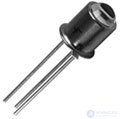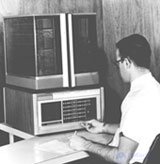Lecture
 Element base of the second generation steel semiconductors. Transistors have replaced the non-reliable vacuum tubes. Transistors significantly reduced computers in size and cost. And no wonder. One transistor can replace several dozen electronic tubes. At the same time, the heat release significantly decreased and the power consumption also decreased, and the speed of work became higher. If we compare cars of the first and second generation, then by example it looked like this. Mark-1 is a first-generation computer occupying a huge hall. Its height is 2.5 m and its length is 17 m and at the same time it cost 500 thousand dollars. PDP-8 - second generation computers. The size of a refrigerator, and at the same time it cost only 20 thousand dollars.
Element base of the second generation steel semiconductors. Transistors have replaced the non-reliable vacuum tubes. Transistors significantly reduced computers in size and cost. And no wonder. One transistor can replace several dozen electronic tubes. At the same time, the heat release significantly decreased and the power consumption also decreased, and the speed of work became higher. If we compare cars of the first and second generation, then by example it looked like this. Mark-1 is a first-generation computer occupying a huge hall. Its height is 2.5 m and its length is 17 m and at the same time it cost 500 thousand dollars. PDP-8 - second generation computers. The size of a refrigerator, and at the same time it cost only 20 thousand dollars.
The word transistor comes from two English words transfer - transfer, resistor - resistance. A semiconductor device that works as a switch. Modern transistors are made on the basis of a single crystal semiconductor.
 Similar properties, like a semiconductor there is an electron tube. When the cathode is heated, emission occurs and current flows in one direction. From the cathode to the anode which is positively charged. There is no voltage in the opposite direction. Hence the idea to use semiconductors instead of electronic tubes. This saves energy, cooling costs and makes computers more reliable.
Similar properties, like a semiconductor there is an electron tube. When the cathode is heated, emission occurs and current flows in one direction. From the cathode to the anode which is positively charged. There is no voltage in the opposite direction. Hence the idea to use semiconductors instead of electronic tubes. This saves energy, cooling costs and makes computers more reliable.
A diode is an example of the simplest semiconductor. Its principle lies in the properties between metal and semiconductor. They are used in equipment that serves to convert electrical oscillations. They rectify the current and therefore used in stabilizers. In the second generation of machines, the diodes began to be actively used. On their basis, the schemes of decoders and passively storing devices are built.
Together with the replacement of lamps with transistors, the element base for information storage was improved. Not only punched tapes and punched cards, but also magnetic tape were used to store information. What greatly accelerated the input-output information in the car. By the beginning of the 60s began to use disk drives on magnetic disks. What is even more accelerated information processing.
Previous tube computers needed additional equipment. In the basements of computer centers were power supply air conditioning. With the advent of the second generation of computers, the need for them has disappeared.
In addition, the electronic - vacuum tube works if and only if an emission current passes through it. Emission occurs when the cathode of the lamp is heated to a high temperature. Cars of the previous generation had tens of thousands of such lamps. To feed them needed was not a small electrical energy. From 50-150 kilowatts.

Magnetic core or ferrite memory
Magnetic core memory was also used. Representing a matrix of small rings that are polarized in two directions. That corresponded to one bit of information. Technology is well suited as a computer RAM. The boards were collected almost by hand and were very expensive. And their volume was about 32 KB.
Magnetic core memory or ferrite memory as it is also called. Built on the basis of ferrite is a semiconductor but has certain magnetic properties. They are made from magnetic iron ore with admixtures of magnesium and nickel. Their dignity is that they can quickly magnetize and maintain their magnetized state. Ferrites have high resistance and current losses during their magnetization are minimal. Ferrites are made of cores. They resemble ordinary rings. These rings are arranged in rows forming a matrix. The so-called memory board. On each core there are two windings for writing a data bit and one for reading.
In the UNIVAC and LARC machine, magnetic drums were first used. IBM for their computers IBM 1401, IBM 1410 used magnetic disks.
However, what is the difference between the second generation and the first? In their element base. Transistors replaced the lamp. As a result, increased productivity. Decreased power consumption. Reduced heat generation. No need for powerful air conditioning.
Among the Soviet computers of the second generation became Minsk-22. He could perform up to five thousand elementary operations per second. His RAM was built on ferrite cores, the volume of the order of six - eight thousand numbers. It used magnetic disks that could store several million numbers. D information was through punched cards and punched tapes. For output given to him it was possible to connect an alphabetic - digital printing device. The subsequent model Minsk-32 could already perform 250 thousand operations per second. The amount of RAM was 65 536 bytes.

PDP-8 computer of the second generation. Production Corporation DEC.
With the advent of second-generation computers, their use has expanded. From government and military institutions they began to appear in private organizations and institutions. Mainly by reducing the cost of machines and the development of software. Began to create special system software. Appeared batch processing systems. The predecessors of operating systems. Which were intended to control the computational process. A formal task management language was developed. Set of several tasks, in the form of a deck of punched cards. Got the name of the task package. This approach is still alive. In DOS bat - files, in Windows cmd - files. Then the operating systems did not take long to wait. It is for computers of the second generation began to develop operating systems. This greatly accelerated the management of computers.
Much attention was paid to the improvement of programming machines. In the 50s, the first programming languages began to appear: B0, Fact, MathMatic and others. In the wake of them appeared high-level languages Fortran , Algol . Later they began to develop libraries in which previously created functions were stored. Written once they were called again.
Comments
To leave a comment
History of computer technology and IT technology
Terms: History of computer technology and IT technology